| Article ID | Journal | Published Year | Pages | File Type |
|---|---|---|---|---|
| 5016761 | International Journal of Plasticity | 2017 | 22 Pages |
Abstract
In an earlier work, we derived evolution equations governing the dynamic growth of voids considering the combined retarding effects of micro-inertia and dislocation kinetics. Here we derive closed-form approximate solutions to these governing equations that accurately capture the transient evolution of void size history. In addition to being invaluable to the development of computationally-efficient dynamic ductile failure frameworks, these closed-form models help reveal deeper insights into the underlying physics governing complex dynamic void growth. In particular, we show that the transient effects of inertia are important for families of voids that nucleate from coarse, micron-sized second phase particles. For nano-sized voids the finite kinetics of dislocation substructure evolution towards a saturated state play a vital role. In spite of the significant complexity associated with capturing an evolving substructure, an elegant closed-form approximation presents itself. These closed-form models are further bolstered by good agreement with molecular dynamics calculations. Lastly, we derive closed-form models of void size distribution evolution to confirm an experimentally observed transition in fracture surface characteristics above a critical loading rate.
Related Topics
Physical Sciences and Engineering
Engineering
Mechanical Engineering
Authors
J.W. Wilkerson,
